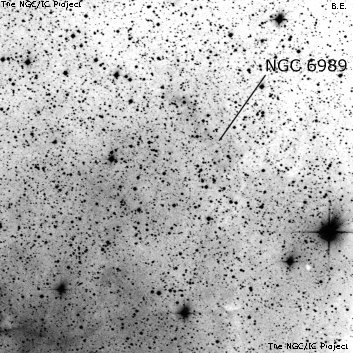NGC/IC Project Restoration Effort
(This is a very very beta version)
NGC6989


Basic Information
Location and Magnitude
Right Ascension: 20:54:6.0
Declination: +45:14:26
Constellation: CYG
Visual Magnitude:
Historic Information
Discoverer: Herschel W.
Year of discovery: 1790
Discovery aperture: 18.7
Observational
Summary description: Cl, cL, st pS
Sub-type: *Grp
Corwin's Notes
=====
NGC 6989 is listed as non-existent in RNGC. However, it seems to be a
grouping in the northern reaches of the North America Nebula looking pretty
much as WH saw it, "A large cluster of pretty small stars of several sizes."
I put the position within a minute or two of WH's position, and make the
diameter seven or eight arcminutes. This may not, however, be a real cluster,
but simply a random group of stars in the rich Milky Way field.
And it may not be the object that WH saw. JH looked for his father's cluster,
VIII 82, twice, once saying only "Viewed. A mere clustering portion of the
Milky Way," without determining a position for it. The second night, he makes
it a "Coarse, poor, pretty large cluster; stars small." He determined a
position for it then, but it is 2 minutes, 15 seconds of time east, and 12.5
arcmin north of his father's position. So, when it came time to prepare the
GC, he made two separate clusters out of the observations he had at hand.
Since there are "clustering portions of the Milky Way" at both positions,
I've kept JH's separate entries as they appear in GC and NGC. The other entry
is NGC 6996, which see.
NGC 6997 is a third cluster, probably a real one, in the North America Nebula.
See its discussion for even more information.
Steve's Notes
=====
NGC 6989
17.5" (9/23/95): at 100x appears to be simply a large Milky Way field about 20' diameter in the "Canada" portion of the "North American" nebula. Weakly more enhanced than the surrounding star field and only distinguished because of four bright stars off the south side including mag 5.5 SAO 50187 (off the SW edge) and three mag 7.5-8.5 cradling the south edge and forming an obtuse isosceles triangle. Requires low power or appears similar to the average Milky Way patch.



